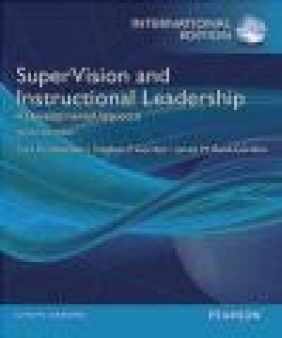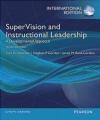SuperVision and Instructional Leadership
Stephen Gordon, Carl Glickman, Jovita Ross-Gordon
SuperVision and Instructional Leadership
Stephen Gordon, Carl Glickman, Jovita Ross-Gordon
- Producent: Pearson
- Rok produkcji: 2013
- ISBN: 9780133147285
- Ilość stron: 480
- Oprawa: Miękka
Niedostępna
Opis: SuperVision and Instructional Leadership - Stephen Gordon, Carl Glickman, Jovita Ross-Gordon
Note: This is the bound book only and does not include access to the Enhanced Pearson eText. To order the Enhanced Pearson eText packaged with a bound book, use ISBN 0133388506. This leading text's emphasis on school culture, teachers as adult learners, developmental leadership, democratic education, and collegial supervision has helped redefine the meaning of supervision and instructional leadership for both scholars and practitioners. The Ninth Edition maintains its comprehensive approach to supervision and instructional leadership and presents new and engaging material throughout. Chapters on knowledge, interpersonal skills, technical skills, technical tasks, and cultural tasks for successful supervision and instructional leadership are included, and the authors emphasize the importance of collegiality, understanding adult learning and development, reflective inquiry, democracy, addressing diversity, the change process, and community building. This is a resource that students purchase, use in class, and reference throughout their careers as educational leaders. The Enhanced Pearson eText features embedded video. Improve mastery and retention with the Enhanced Pearson eText* The Enhanced Pearson eText provides a rich, interactive learning environment designed to improve student mastery of content. The Enhanced Pearson eText is: * Engaging. The new interactive, multimedia learning features were developed by the authors and other subject-matter experts to deepen and enrich the learning experience. * Convenient. Enjoy instant online access from your computer or download the Pearson eText App to read on or offline on your iPad(R) and Android(R) tablet.* * Affordable. The Enhanced Pearson eText may be purchased stand-alone or with a loose-leaf version of the text for 40-65% less than a print bound book. *The Enhanced eText features are only available in the Pearson eText format. They are not available in third-party eTexts or downloads. *The Pearson eText App is available on Google Play and in the App Store. It requires Android OS 3.1-4, a 7" or 10" tablet, or iPad iOS 5.0 or later.TABLE OF CONTENTS About the Authors xiii Preface xv PART ONE Introduction 1 1 SuperVision for Successful Schools 3 SuperVision: A New Name for a New Paradigm 7 Supervisory Glue as a Metaphor for Success 9 Who Is Responsible for Supervision? 9 Supervision and Moral Purpose 12 Organization of This Book 13 Reflective Exercise 15 PART TWO Knowledge 17 2 The Norm: Why Traditional Schools Are as They Are 19 The Work Environment or Culture of Schools 20 The Legacy of the One-Room Schoolhouse 21 Cultures within Cultures 30 Blaming the Victim and Structural Strain 31 Reflective Exercise 32 3 The Dynamic School 33 Shared Leadership, Collegiality, and Collaboration 34 A Cause beyond Oneself 35 Professional Development 36 Positive Learning Climate 37 Authentic Curriculum, Instruction, and Assessment 38 Democracy 39 Inquiry 40 Cultural Responsiveness 41 Partnerships and Networks 42 Reflective Exercise 47 4 Adult and Teacher Development within the Context of the School 48 Adults as Learners 49 Adult and Teacher Development 59 Development: Ebb and Flow 76 Reflective Exercise 78 5 Reflections on Educational Beliefs, Teaching, and Supervision 79 Instructional Goals and Effective Teaching 81 Expert Teachers 82 Beliefs about Education 84 Supervisory Beliefs 85 Supervisory Platform as Related to Educational Philosophy 87 Checking Your Own Supervisory Beliefs 91 What Does Your Belief Mean in Terms of Supervisor and Teacher Responsibility? 91 Reflective Exercise 96 PART THREE Interpersonal Skills 97 6 Supervisory Behavior Continuum: Know Thyself 99 Outcomes of Conference 102 Valid Assessment of Self 103 Johari Window 104 Cognitive Dissonance 106 Comparing Self-Perceptions with Others' Perceptions 107 Comparing Self-Perceptions to Recorded Behaviors 109 360-Degree Feedback 110 Reflective Exercise 111 7 Directive Control Behaviors 113 A History of Overreliance on Control 116 Issues in Directive Control 118 When to Use Directive Control Behaviors 118 Moving from Directive Control toward Directive Informational Behaviors 119 Reflective Exercise 120 8 Directive Informational Behaviors 121 Comparing Directive Control and Directive Informational Statements 123 Issues in the Directive Informational Approach 126 When to Use Directive Informational Behaviors 127 Moving from Directive Informational toward Collaborative Behaviors 127 Reflective Exercise 128 9 Collaborative Behaviors 130 Issues in Collaborative Supervision 135 When to Use Collaborative Behaviors 136 Moving from Collaborative toward Nondirective Behaviors 136 Reflective Exercise 137 10 Nondirective Behaviors 139 Initiating Nondirective Supervision 144 Nondirective, Not Laissez-Faire, Supervision 145 Issues with Nondirective Supervision 146 When to Use Nondirective Behaviors 147 Nondirective Supervision, Teacher Collaboration 148 Reflective Exercise 149 11 Developmental Supervision 150 Phase 1: Choosing the Best Approach 151 Phase 2: Applying the Chosen Approach 155 Phase 3: Fostering Teacher Development 156 Not Algorithms, but Guideposts for Decisions 158 Case Studies on Developmental Supervision 158 Reflective Exercise 168 PART FOUR Technical Skills 169 12 Assessing and Planning Skills 171 Personal Plans 172 Assessing Time 173 Changing Time Allocations: Planning 176 Assessing and Planning within the Organization 180 Ways of Assessing Need 181 Analyzing Organizational Needs 185 Planning 189 Cautions Concerning Planning 195 Reflective Exercise 196 13 Observing Skills 197 Formative Observation Instruments Are Not Summative Evaluation Instruments 200 Ways of Describing 200 Quantitative Observations 200 Qualitative Observations 209 Tailored Observation Systems 213 Types and Purposes of Observation 216 Technology-Enhanced Observation 217 Collaborative Walkthroughs 219 Cautions Concerning Observations 220 Reflective Exercise 221 14 Evaluation Skills 222 The Intersection of Instructional Supervision and Program Evaluation 223 Judgments 224 Key Decisions in the Program Evaluation Process 225 Overall Instructional Program Evaluation 227 Program Evaluation and Teacher Empowerment 232 Teacher Evaluation 234 Teacher Self-Evaluation 239 Reflective Exercise 240 PART FIVE Technical Tasks of Supervision 243 15 Direct Assistance to Teachers 245 Clinical Supervision 246 Comparing Clinical Supervision with Teacher Summative Evaluation 250 Integrating Clinical Supervision and Developmental Supervision 251 Peer Coaching 252 Other Forms of Direct Assistance 255 Beyond Technical Assistance: Improving Classroom Culture 257 Reflective Exercise 257 16 Group Development 258 Dimensions of an Effective Group 260 Group Member Roles 261 Applying Developmental Supervision to Groups 266 Dealing with Dysfunctional Members 268 Resolving Conflict 269 Preparing for Group Meetings 273 Establishing Ground Rules 274 Collaborative Groups and School Improvement 275 Dialogue: An Alternative Group Process 278 Reflective Exercise 279 17 Professional Development 281 Characteristics of Successful Professional Development Programs 283 Integrating Schoolwide, Group, and Individual Professional Development 284 Alternative Professional Development Formats 285 Examples of Effective Professional Development Programs 287 Stages of Professional Development 290 Evaluating Professional Development Programs 291 Teachers as Objects or Agents in Professional Development 294 Reflective Exercise 297 18 Curriculum Development 297 Sources of Curriculum Development 298 Legislated Learning 299 Curriculum Development as a Vehicle for Enhancing Collective Thinking about Instruction 301 What Should Be the Purpose of the Curriculum? 302 What Should Be the Content of the Curriculum? 302 How Should the Curriculum Be Organized? 304 In What Format Should the Curriculum Be Written? 305 Curriculum Format as Reflective of Choice Given to Teachers 309 Relationship of Curriculum Purpose, Content, Organization, and Format 310 Levels of Teacher Involvement in Curriculum Development 311 Integrating Curriculum Format with Developers and Levels of Development 312 Matching Curriculum Development with Teacher Development 313 The Curriculum and Cultural Diversity 315 Reflective Exercise 320 19 Action Research: The School as the Center of Inquiry 321 How Is Action Research Conducted? 323 A Developmental Approach to Action Research 324 Decisions about Action Research 325 Action Research: Vehicle for a Cause beyond Oneself 327 Characteristics of Successful Action Research 328 Example of Action Research 330 Expanding Boundaries: Alternative Approaches to Action Research 331 Shared Governance for Action Research 333 Premises 334 Suggestions for Assisting Action Research 338 Conclusion: Focus, Structure, and Time for Development 339 Reflective Exercise 339 PART SIX Cultural Tasks of SuperVision 341 20 Facilitating Change 343 Chaos Theory 345 Postmodern Theory 349 Education Change Theory 352 Change at the Individual Level 359 Changing the Conditions of Teaching 359 Reflective Exercise 363 21 Addressing Diversity 365 Achievement Gaps among Economic, Racial, and Ethnic Groups 367 A Societal or a School Problem? 368 Cultural Clashes 370 Culturally Responsive Teaching 374 Culturally Responsive Schools 377 Gender Equity 382 Equity for Sexual Minorities 384 Overarching Patterns 387 Connecting the Technical Tasks of Supervision to Cultural Responsiveness 388 Reflective Exercise 388 22 Building Community 390 Democratic Community 392 Moral Community 395 Professional Learning Community 398 Community of Inquiry 400 Engagement with the Larger Community 402 Five Attributes, One Community 405 Conclusion 406 Reflective Exercise 407 Appendix A: Educational Philosophy? Q Sort* 409 Appendix B: Review of Interpersonal Behavior in Four Supervisory Approaches 415 References 417 Name Index 439 Subject Index
Producent:
GPSR Pearson Central Europe Sp. z o.o.
ul. Szamocka 8
01-748 Warszawa (PL)
tel: 459 596 060
email: [email protected]
Szczegóły: SuperVision and Instructional Leadership - Stephen Gordon, Carl Glickman, Jovita Ross-Gordon
Tytuł: SuperVision and Instructional Leadership
Autor: Stephen Gordon, Carl Glickman, Jovita Ross-Gordon
Producent: Pearson
ISBN: 9780133147285
Rok produkcji: 2013
Ilość stron: 480
Oprawa: Miękka
Waga: 0.62 kg






























